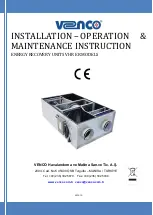
34
OPI-POWER LIFT HF 7000-8000-V1.0-EN
7.2 Cleaning the lift
A regular and expert clean helps retain the value
of the lift.
Additionally, it can also be a pre-requisite for the
preservation of guarantee claims for any eventual
corrosion damage.
The best protection for the lift is regular removal of
contaminants of any kind.
This includes above all:
• De-icing salt
• Sand, pebbles, earth
• Industrial dust of all types
• Water, also in connection with other environmen-
tal influences
• Aggressive deposits of all types
•
Permanent humidity due to insufficient ventilation
The frequency of lift cleaning depends, among oth-
er things on the frequency of use, of lift handling,
of workshop cleanliness, and the location of the
lift. Furthermore, the degree of contamination de-
pends on the time of year, the weather conditions
and workshop ventilation. Under adverse circum-
stances, weekly lift cleaning might be required,
however a monthly cleaning may be sufficient.
Do not use and aggressive and abrasive materials
for cleaning, rather use mild cleaners, e.g. a com-
mercially available detergent and lukewarm water.
• For cleaning, do not use high pressure washers
(e.g. steam cleaners).
• Carefully remove all contamination with a
sponge, or if required with a brush.
• Make sure that there is no residue of the cleaner
on the lift.
• Dry the lift with a cloth and spray it with a spray
wax or oil.
•
Moving parts (bolts, bearing zones) are to be lu
-
bricated or oiled according to instructions.
•
When cleaning the workshop floor ensure that no
aggressive cleaning materials come into contact
with lift surfaces. Permanent contact with any
kind of liquid is prohibited.
7.3 Checking the stability of the lift
Retighten nuts of the approved fastening anchors
to the torques specified by the manufacturer using
a pre-set torque wrench (Torque details are found
on the data sheet of the corresponding anchor
manufacturer).
8 Assembly and commissioning
8.1 Set up guidelines
• Lift set up is done by trained manufacturer per-
sonnel or a contract partner. Set up is to be done
according to the assembly instructions.
•
A standard lift may not be set up in explosion en
-
dangered spaces or wash halls.
•
Before setting up, ensure or make a sufficient
foundation.
• A level set up space is to be done in all cases,
where open air and enclosed foundations where
frost is expected, must have a frost-depth thick
-
ness.
• An on-site standard electrical connection of
1 ~/N + PE, 230 V, 60 Hz is to be provided.
• The lines can be fed through the cross-beams. In
all cases, prevent kinks or tensional loads on the
lines.
•
After successful lift installation and before first
commissioning, the operating company must
have the lift grounding conductors inspected on-
site according to IEC regulation (60364-6-61). An
insulation resistance test is also recommended.
8.1.1 Set up and anchoring the lift
i
On-site provision of suitable auxiliary materials
(e.g. forklifts, crane, etc.) are to be made avail-
able for unloading the lift and for assembly.
Before setting up the lift, the operating company
must ensure or make a sufficient foundation. For
this, a normal reinforced concrete floor with a val
-
ue of a min. C20/25 is required. The minimum foun-
dation thickness (without screed and tiles) is to be
taken from the foundation plan in this document.
In our plans, we inform of the minimum specifica
-
tions for the foundation, however local conditions
(e.g. underground, floor quality, etc.) are outside of
our responsibility. In special cases, the design of the
installation location must be individually specified
by planning architects and statics experts. Open air
foundations must be made to frost depth.
The operating company of the lift is solely responsi-
ble for the set up location.
If the lift is to be assembled on an existing con
-
crete floor, cement quality and strength are to
be checked beforehand. In case of doubt, make
a test bore and insert an anchor. Then, tighten
the anchor to the manufacturer recommended
torque. After inspection within the anchor zone of
influence (200 mm diameter) (see technical data
sheet of the anchor manufacturer), if there is visible
damage (hairline cracks, cracks or similar), or if the
required torque cannot be applied then the set up
location is unsuitable.
Содержание POWER LIFT HF 7000
Страница 2: ...2 OPI POWER LIFT HF 7000 8000 V1 0 EN...
Страница 4: ......
Страница 20: ...20 OPI POWER LIFT HF 7000 8000 V1 0 EN...
Страница 21: ...OPI POWER LIFT HF 7000 8000 V1 0 EN 21...
Страница 22: ...22 OPI POWER LIFT HF 7000 8000 V1 0 EN...
Страница 23: ...OPI POWER LIFT HF 7000 8000 V1 0 EN 23...
Страница 54: ......
Страница 66: ...66 OPI POWER LIFT HF 7000 8000 V1 0 EN SPX 280 Unit USA...
Страница 67: ...OPI POWER LIFT HF 7000 8000 V1 0 EN 67 SPX Unit USA...
Страница 68: ...68 OPI POWER LIFT HF 7000 8000 V1 0 EN Cross beam 240SLK05840_1 07 09 2018...
Страница 70: ...70 OPI POWER LIFT HF 7000 8000 V1 0 EN Cylinder K HF7000 HF8000 240SLK02501_2...
Страница 71: ...OPI POWER LIFT HF 7000 8000 V1 0 EN 71 Cylinder F HF7000 HF8000 240SLK02602_2...
















































